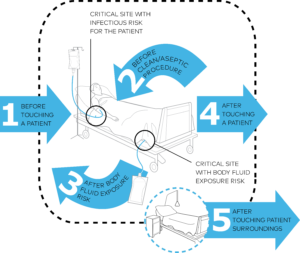Key terms
Healthcare-Associated or Hospital-Acquired Infections, (HAI, nosocomial infections) are a result of treatment in a hospital, or healthcare service unit, not related to the patient’s original condition. Infections are considered nosocomial if they first appear 48 hours or more after hospital admission and within 30 days after discharge.
Hand hygiene is the generic term most often used to address both the surgical hand washing and hand rubbing procedures, performed with soap or alcohol-based rubs. The protocol is defined in European Norms EN 1499 and EN 1500, in accordance with the World Health Organization (WHO) recommendations. In addition, the proper technique has to be maintained over time (through re-education and training), which receives very little attention.
Hand hygiene compliance refers to the willingness of the staff to practice proper hand washing at every occasion when the protocol or the recommendations require. WHO’s 5 moments of hand hygiene requires hand rubbing before touching a patient, before clean/aseptic procedures, after body fluid exposure/risk, after touching a patient and after touching patient’s surroundings. This supposedly means up to hundreds of hand hygiene events within one shift, therefore proper execution of the protocol is very important.
HAI numbers
Hospitals are losing the fight against nosocomial infections that affect 1.4 million people per day, and killing 100 000 in the US annually. On average, 7% of patients acquire HAI in the Western world. This means that every 14–15th patient acquire a secondary infection during the treatment (mostly multi-resistant stems).
USA situation
The overall annual direct cost of HAI to US hospitals ranges from €3–6 billion, and collateral costs (e.g., days off, rehabilitation and permanent health damage) pile up to €27–34 billion, as HAI may triple average hospitalization time. Effective hand washing has shown to decrease HAI by 30%, saving an annual €2–4 million unnecessary cost per hospital. As a result, 34 states have implemented standards that require hospitals to improve hand hygiene, although technology-driven solutions are lagging behind the clinical need.
European situation
According to the European Commission, there are approximately 4.1 million patients who suffer from HAI and 150 000 attributable deaths in the EU each year. It also generates 16 million extra days of hospital stay per year (an average of four days per infection), creating a significant cost burden of €10–18 billion in the 15,000 European hospitals.
Rest of the World
Recent studies showed that the developing world has three times higher HAI ratio, and on average, there are 47.9 incidents per 1000 patient days at ICUs. The biggest markets in Asia are still emerging, while healthcare related investments are at a smaller scale. However, e.g., the Indian market has been expanding rapidly since the 1990s, yet the country has a reported HAI ratio of 25%. Healthcare grew at a compound annual rate of 16%. By 2012, the sector is projected to grow to nearly €30 billion. Of the 15,400 hospitals roughly two third are public with inadequate infrastructure and the government has already taken measures to improve this: the National Rural Health Mission 2005–2012 was launched aiming to develop effective healthcare.
Alcohol-based hand rubs are recognized as the most effective tool to prevent HAI, therefore these became a standard and a European Norm. Governments and insurance companies are now explicitly charging the hospitals the avoidable costs of HAI.
HAI Prevention
Hand washing is the single most important procedure to prevent infections. In most cases germs are transferred via hands. Sanitizing your hands reduces the chance of getting infected, or to infect others. Alcohol-based hand rubs have been recognized as the most effective way of hand sanitizing.
World Health Organization’s (WHO) 5 moments, when healthcare workers should wash their hands:

The hand washing protocol is defined in European Norms EN1499 (hygienic handwash) and EN 1500 (hygienic hand disinfection)in accordance with WHO recommendations. In addition, the proper technique has to be maintained over time (through re-education and training), which receives very little attention.

